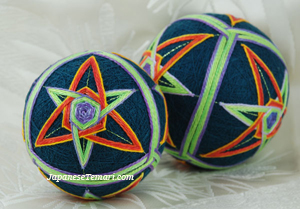The Story of the Arrow and the Turtle
Or
How to Translate Mitsubane Kikkou Kagari for Temari
三つ葉ね拮抗かがり 
Mitsubane = this word has been translated several different ways. Mitsu definitely means three. Bane is a form of hane. It changes spelling because it's behind the counter mitsu. Hane means feather. It also means wing. One time I went to Birmingham, Ala, to a temari stitch-in. Our host invited a Japanese guy who was living in Birmingham and studying for his PhD in math. I asked him about the meaning of this term. Told him I though it meant triwing. That is what Mary Woods calls it in her book. He said no, not really. This is a special word that to a Japanese person brings to mind the arrangement of the three feathers on the end of an arrow. Not just any three wings or feathers. They should all be pointing in towards the center and arranged symmetrically out from the center. Well, this guy was a mathematician and I thought his explanation outstanding! Not wings but feathers. Not "tri" but three. A visual of the design as well as a little bit of Japanese culture (the importance of the arrow).
kikkou - He also told me this means tortoise shell hexagon shape although there is a different word for tortoise shell in my dictionary. And a totally different word for turtle or tortoise. The hexagon shape that forms in the middle of this stitch design is often used in Japanese art, clothing, etc., to represent the turtle or tortoise. So this makes sense.
kagari - means stitching.
So, where are we?
Mary Woods was the only author of an English temari book to refer to this term. She selected triwing with hexagon (to mean the layered version) and tri-wing without hexagon (to mean the interlocked version).
The deadline loomed for my book, Japanese Temari. What was I to do? I had badgered my friends and students so much about terminology that I'm sure they were thinking ENOUGH ALREADY! But I needed to come to a happy place for me with this term. I was so impressed with the mathematician's explanation. But I could not call the stitch "three feathers like on the end of an arrow and hexagon tortoise shell stitching"!!! I did not feel like Mary Woods term triwing with or with hexagon reflected the symbolism and the story behind the design. I love symbolism and stories because they help me remember how to do the stitching.
Finally, I asked my husband. I drew it on a piece of paper and said "what is this?" He said - that's a trefoil. I looked it up and surely enough, it is a trefoil shape. Many stitchers were already using this term trefoil. Others used tri-wing or a variation of tri-wing. Most people just did not talk about it. They just stitched it. A classroom full of students voted for trefoil. So I used trefoil in my book.
A few years passed.
Happy stitching, teaching, and learning years.
I notice now that many people are preferring to say simply tri-wing for this design. I notice that I, too, am liking the term tri-wing. No hexagon mentioned. No feathers, arrows or turtles mentioned.
Terminology evolves, that's for sure. What will you call it? I don’t recommend using the Japanese words unless you are fluent. I lived there long enough to know how much trouble one can get into through mispronunciation!